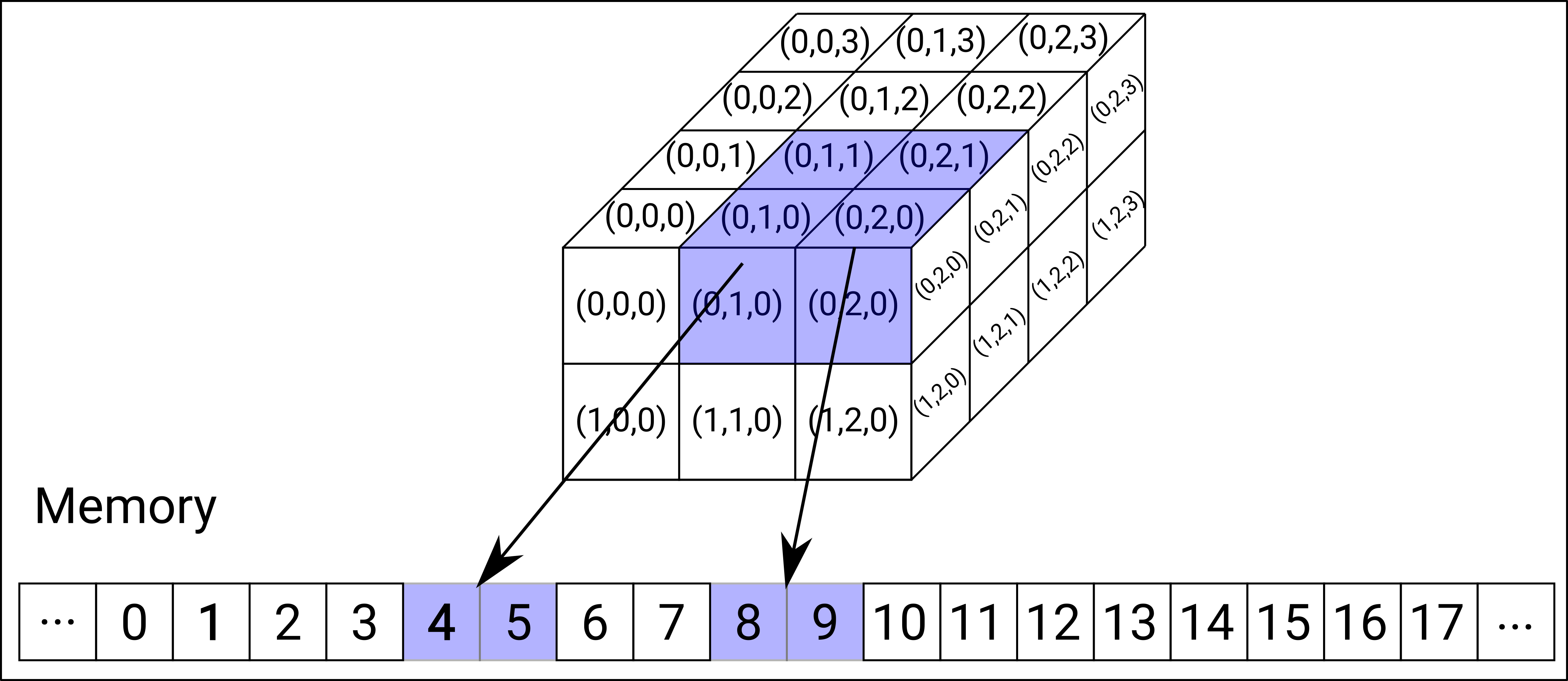What's a Holor container?¶
Holor containers are generic multi-dimensional collections of homogeneous elements, i.e., all elements must be of the same type. These containers are characterized by:
- the number of dimensions
N; - the
lengths, that is the number of elements along each individual dimension; - the type of the elements stored.
From the point of view of implementation, holor containers have three fundamental components:
- Memory: a holor container has access to a contiguous area of memory where the "contained" elements are stored.
- Layout: each holor container possesses a
Layout, an object that contains the information to map from the the multi-dimensional coordinates (indices) in the container dimensions to a memory location, and viceversa. In particular, holor containers use a row-major ordering. - Indexing/Slicing operations: a holor container is endowed with a set of operations that allow to access its individual elements from a set of
Ncoordinates (indexing), or to extract a holor container that is a subset of the original one (slicing)

Memory¶
Each holor container has access to a contiguous area of memory where its elements are stored. The library provides two different types of containers, which differentiate from each other for the ownership of the storage:
- A
Holoris a container that has ownership of the memory where the elements are stored. This is implemented as anstd::arraywithin the container. - A
HolorRefis a non-owning Holor-like view over a sequence of elements stored in a contiguous area of memory. This is implemented as a pointer to the memory location.
Layout¶
A Layout contains the essential information needed to map the indices of the holor container to a location in the memory where the elements are stored.
- Offset: the displacement in the contiguous memory of the first element indexed by the layout from the beginning of the memory.
- Lengths: the numbers of elements along every dimension of the layout.
- Strides: the distances in the 1D memory sequence between successive elements in individual dimensions of the layout.
Important
For a Layout with N dimensions, both lengths and strides must have size N.
For a generic N dimensional holor container, the total number of elements stored is
\begin{equation}
size = \prod_{i=0}^{N-1} lengths[i]
\end{equation}
The index of the memory location corresponding to the element of the container with coordinates \((c_0, \ldots, c_{N-1})\) is \begin{equation} index = offset + \sum_{i=0}^{N-1} c_i \cdot strides[i] \end{equation}
Indexing and Slicing operations¶
Holor containers are endowed with operations that allow to index individual elements of the container, accessing the memory location where they are stored, or to slice parts of it yielding a new view (i.e., a HolorRef) over the selected part of the container.
The indexing and slicing operations have a simple sintax common to many scripting languages. For example, one can write
using namespace holor;
Holor<int,2> A = {{1,2,3,4},{5,6,7,8},{9,10,11,12}}; // 3-by-4 matrix of integers
auto c = A(2,3); // indexing a single element. c has the value 8.
auto B = A(range(0,1), range(2,3)); // Slicing a 2-by-2 matrix. B is a HolorRef that views the elements {{3,4}, {7,8}} of A
For more detailed examples refer to the section Tutorials.
Example: indexing¶
Consider a \(2 \times 3 \times 4\) Holor as in figure.

The container has 24 elements which are stored contiguously. The Holor's Layout has:
- offset = 0;
- lengths = [2, 3, 4];
- strides = [12, 4, 1];
The element with coordinates (0,0,0) is located ath the position \(0 + 0 \cdot 12 + 0 \cdot 4 + 0 \cdot 1 = 0\) of the memory, whereas the element with coordinates (0,2,2) is located in the memory area at the position \(0 + 0 \cdot 12 + 2 \cdot 4 + 2 \cdot 1 = 10\).
Example: slicing¶
Consider the same \(2 \times 3 \times 4\) Holor as in the previous example, and suppose that we want to take a 2-by-2 slice corresponding to the first row, last two columns and first two lines in the third dimension. In code, this would be
auto B = A(1, range(0,1), range(0,1)); //suppose that A is the name of the Holor to be sliced

The slicing operation extracts a subset of the Holor container. The slicing operation does not create a new Holor, rather it returns a HolorRef that provides a view over the selected slice. For this purpose, a new Layout that describes the location of the selected elements in the original contiguous memory is computed. In this example, the Layout corresponding to the selected 2-by-2 slice is:
- offset = 4
- lengths = [2, 2]
- strides = [4, 1]